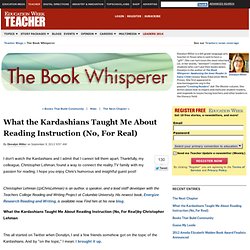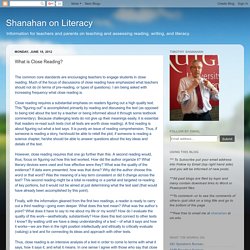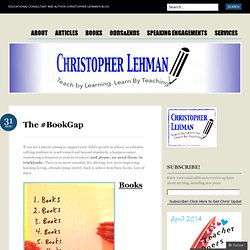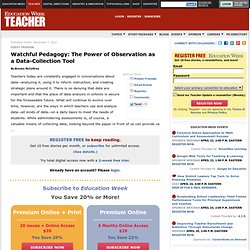

Colored Overlays. Journey North Instructional Strategies. What the Kardashians Taught Me About Reading Instruction (No, For Real) - The Book Whisperer. I don't watch the Kardashians and I admit that I cannot tell them apart.

Thankfully, my colleague, Christopher Lehman, found a way to connect the reality TV family with my passion for reading. I hope you enjoy Chris's humorous and insightful guest post! Christopher Lehman (@iChrisLehman) is an author, a speaker, and a lead staff developer with the Teachers College Reading and Writing Project at Columbia University. His newest book, Energize Research Reading and Writing, is available now. Find him at his new blog. What the Kardashians Taught Me About Reading Instruction (No, For Real)by Christopher Lehman This all started on Twitter when Donalyn, I and a few friends somehow got on the topic of the Kardashians.
Which got me to thinking--and please follow me on this one--we could learn a lot about reading instruction from this particular reality TV family. Brand Yourself as a Reader, So Your Students Will Emulate. Five close reading strategies to support the Common Core. I walked in to my first college class, Political Science 101, eager to learn.

For my inaugural college assignment, my professor asked the class to read the first three chapters of the textbook for the next class period. That night, I returned to my dorm room, determined to learn everything I could in those three chapters. I pulled out my textbook and highlighter. Growing up, that is what I always saw the “older kids” using when they read a textbook. In my naïve 18-year-old mind, I believed that highlighters must have some magical power that transports the words on the page directly to your brain. However, when I opened my textbook it was unlike anything I had read in high school.
I shrugged, pulled out my highlighter and started highlighting. I quickly realized that I had no real game plan for reading this complicated textbook. Flash forward to my first few years of teaching. What is Close Reading? The common core standards are encouraging teachers to engage students in close reading.

Much of the focus of discussions of close reading have emphasized what teachers should not do (in terms of pre-reading, or types of questions). I am being asked with increasing frequency what close reading is. Close reading requires a substantial emphasis on readers figuring out a high quality text. This "figuring out" is accomplished primarily by reading and discussing the text (as opposed to being told about the text by a teacher or being informed about it through some textbook commentary). Because challenging texts do not give up their meanings easily, it is essential that readers re-read such texts (not all texts are worth close reading). However, close reading requires that one go further than this. Finally, with the information gleaned from the first two readings, a reader is ready to carry out a third reading—going even deeper. Should I give the students a preview of a text? eBooks for eKids! Digital Booktalk.
Lit For Kids. Christopher Lehman. If you are a parent aiming to support your child’s growth in school, an educator rallying students to reach toward and beyond standards, a business owner considering a donation to your local school (and please, we need them, in truckloads).

There is no more essential, life-altering, test-score-improving, learning-loving, ultimate-jump-starter, back to school item then: books. Lots of them. Look at your classroom and school library, or those of your children’s school, or the ones in the school down the block, and ask yourself if there are enough books to provide enough access to the children in those walls. And if not, there is no more essential back to school supply then filling those shelves. Consider this: A child’s reading level has a direct correlation to test scores. To provide this access educators, like you, often create and build classroom library and school library collections. Let’s do a little math. Take second grade. Boom. 5,880 books. Now could my numbers be a bit off? Watchful Pedagogy: The Power of Observation as a Data-Collection Tool. UserID: iCustID: IsLogged: false IsSiteLicense: false UserType: anonymous DisplayName: TrialsLeft: 0 Trials: Tier Preview Log: Exception pages ( /tm/articles/2012/11/06/fp_mccaffrey.html ) = NO Internal request ( 198.27.80.148 ) = NO Open House ( 2014-04-18 12:51:42 ) = NO Site Licence : ( 198.27.80.148 ) = NO ACL Free A vs U ( 2100 vs 0 ) = NO Token Free (SQMFYBdPPwQPI7IB/XijYT4bbbWkvHI1UofX) = NO Blog authoring preview = NO.
